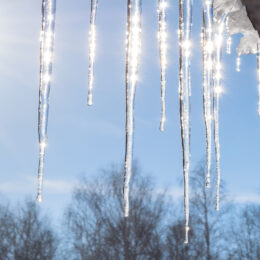
Save energy this winter by using a programmable thermostat. Lowering the temperature while you are asleep or away can save you 10 percent a year on heating and cooling costs.
While saving money through greater energy efficiency may be a year-round objective for many consumers, the way to achieve this goal will vary by season.
There are a number of factors that impact energy efficiency, including weather, the age and condition of the home, and desired comfort levels. During fall and winter months, when the outdoor temperature is chilly, consumers desire a warm home and seek to keep the cold air out. Conversely, in the spring and summer, the focus is on keeping the hot air from infiltrating cool abodes.
Fall and winter: keeping heat in
To maintain a warm indoor environment in chillier weather, there are simple steps you can take to increase energy efficiency.
Fall is a great time to examine seals on doors and windows to check for air leaks. Caulk and weatherstrip as needed to seal in warm air and energy savings. Similarly, examine outlets for air leaks, and where necessary, install gaskets around the outlet to prevent drafts.
During the day, open curtains or drapes on south-facing windows to enable sunlight to heat your home naturally. Close curtains or drapes at night for an added layer of window insulation.
As the temperature drops lower with the onset of winter, schedule a service appointment for your heating system to ensure it is operating at an optimal level. Low-cost or no-cost steps for energy savings include taping or affixing heavy, clear plastic to the inside of your window frames to create an additional barrier against cold air. Ensure that the plastic is tightly sealed to the frame to help reduce infiltration.
Use a programmable thermostat to set the temperature as low as is comfortable when you are home (ideally around 68 degrees). When you are asleep or away, turn the temperature down 10-15 degrees for eight hours. According to the Department of Energy, this small adjustment can help you save approximately 10 percent a year on heating and cooling costs.
Spring and summer: keeping your cool
During warmer months, energy savings and efficiency will require different measures, many of which are inexpensive.
If you live in a climate that is cool, open your windows in the evening and turn off your cooling system while sleeping. In the morning, shut the windows and blinds to hold in the cool air. Where practical, plant trees and shrubs that provide shade in warm months and sunlight in winter. In addition to the aesthetic value, well-placed trees can take heat gain from the sun and provide needed shade by creating a canopy for the house.
In extremely hot weather, your cooling system works harder to close the gap between the high outdoor temperature and the cool indoor thermostat setting. To lessen the difference in temperature between the two, and to lower cooling costs, set the thermostat as high as you can while maintaining your comfort level. Moreover, using a ceiling fan in conjunction with your air conditioning can allow you to increase the thermostat setting approximately four degrees with no reduction in comfort levels.
During the hottest months, it’s all the more critical to replace any remaining incandescent bulbs with LEDs. The waste heat from the old bulbs impacts energy use and creates wasteful and unwanted heat. Employ a programmable thermostat to adjust the settings a few degrees higher when no one is home or your family is sleeping.



